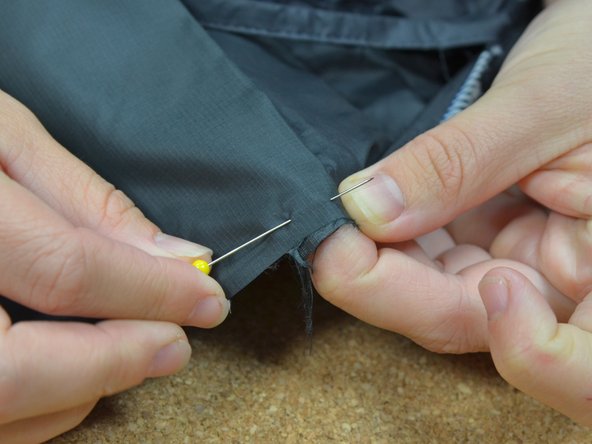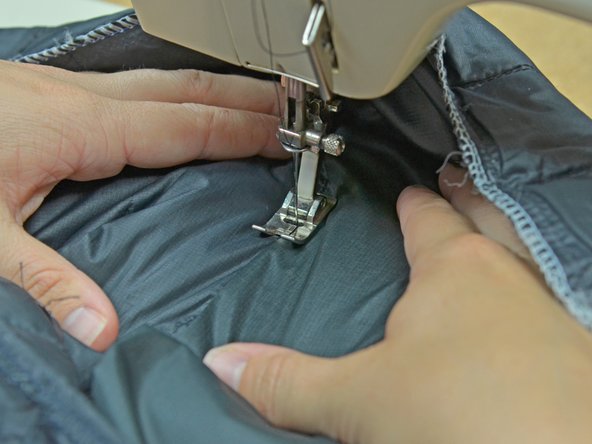소개
The feathers in a down jacket need to be held in place or else they’ll all slide to the bottom of the jacket, leaving your upper torso and shoulders without insulation. The easiest method to prevent this is simply sewing the jacket’s outer and inner fabrics together with seams to keep the feathers from shifting about. While this type of construction solves the problem of feather migration, the seams and corresponding holes in the fabric allow moisture and cold air to penetrate the jacket, decreasing the down’s insulating efficiency. Many Patagonia jackets incorporate internal baffles to keep the down from shifting. The baffle acts like a shelf inside your jacket to hold the down insulation while eliminating the need for seams that pierce both the internal and external fabric. While this is a more complicated construction method, the performance of the finished jacket is greatly improved. This guide shows you how to repair a non-lined portion of your jacket. If you’re not sure whether or not your jacket is lined, or you have a lined jacket, complete our How to Access the Insides of a Patagonia Down Jacket Guide before you follow the steps in this guide.
For replacement parts or further assistance, contact Patagonia Customer Service.
필요한 것
동영상 개요
Down jacket baffle repair overview.
-
-
Locate the hole in your down jacket. In order to prevent all the feathers from escaping through the hole, you'll have to replace the entire baffle.
-
-
-
Turn the jacket inside out.
-
Measure the width of the baffle you're working on. In this case, each baffle looks like it is two inches wide.
-
We are replacing two baffles, so we will need just over four inches of fabric to patch.
-
Measure the length of the baffle (along the baffle seam). In our case, the baffle length is nine inches, and since our repair is in the sleeve, we will double this to eighteen inches for the length of our scrap.
-
-
-
-
Set the pinned piece into the sewing machine.
-
Be sure to use the smallest needle you can find to patch this baffle. This will keep the new stitch from looking too prominent and help prevent the down from escaping through the new stitching holes.
-
Sew directly over the old baffle seam. You will be sewing very close to the edge of the fold, just catching the fabric.
-
Go slowly, and guide the folded edge of the fabric directly over the old baffle seam. You may have to realign the folded edge of the fabric as you go—that's okay.
-
-
-
While you're sewing, be sure to hold the bias tape (which covered the seam edge) out of the way so that it doesn't get caught in the seam.
-
Continue to carefully sew the fold into place.
-
The fabric is very slippery, so be careful and take your time. Judge the seam to your liking.
-
When you come to the end of the seam, backstitch to keep your thread in place.
-
-
-
Turn the jacket right-side out again so you can see the original baffle stitching.
-
Be sure to flip the bias tape out of the inside of the seam so it doesn't get caught as you continue to sew.
-
Align your presser foot on top of the untouched, middle seam (between the two seams you've already sewed).
-
다른 17명이 해당 안내서를 완성하였습니다.
댓글 13개
I could never do this myself. Is there any talented seamster or seamstress out there who has done this before and would like to do my repair for a fee?
Can one buy matching fabric from patagonia?
danilowitz - 답글
Yes, this seems overwhelming. Patagonia, please sell simple, iron-on supplies in your colors. This would be a GENIUS move. I just bought a used Down Sweater for a mere $30 and need to repair 2 holes. My plan is to stitch them tight with a needle & thread in a similar color (it's Viking Blue), but was hoping for a SIMPLE patch solution on here. None exists. Most of us don't have time for replacing baffles, and aren't looking for perfection. Matching colors would be awesome. As would a clear patch that will last through a lifetime of washes, and has Patagonia's seal of approval. I bet you could come out with a line of simple fix-it products. Even if iron-on solutions only last for say, 10 washes or something. Give busy, working moms like me who rely on your outerwear easier solutions so we can continue to buy used and keep up the green circle, so your products continue to see many years of life. :)
"DITTO"
I've been holding onto a brand new vest, worn a few times. It's been years. Feeling guilty for the small burn hole from permitted fire control. Yes, lesson learned. Never wear synthetics to a burn again! All it really needs is a matching stretchy patch I could surgically repair from the inside out. I'd even settle for keeping some on hand to do again once it looses its staying power! A couple of "heatproof synthetic sharp pointed tweezers" is all I would need :).
please upload some vids to: how to repair big down jacket to fit off (from L size to M size)
thank you
Yes, I have been sewing for many years, but I still dont think this repair is as difficult as some of you may think. What's difficult is trying to write out directions for folks who haven't a great deal of sewing experience, so, the author had to include deeply detailed instructions. It may help to think of it as an overly large patch, that simply is the size and shape of the baffles. Fold under edges & stitch - do your best to follow on top of existing stitch lines. Tada! You CAN do it!
I taught myself to sew in the last week and just performed this, its not so bad, but something I had to do which isn’t on the diagram: After unpicking I had to re-sew the sides to stop down escaping, (This may be because I’m untalented with a seem picker but it seemed to only be a loose single thread holding the down in
https://www.patagonia.com/returns.html
Check out the How I built this episode with the Patagonia founder.
How do we order the fabric to match the jacket?
I agree that a matching patch would be sooooo much quicker, even if it doesn’t look good. We have a small hole on the front of a 2 yr old down jacket from a campfire spark. I want to stop the tear, keep the down in, and pass this jacket on to siblings.
Even if it doesn't look great, I agree that a matching patch would be much faster. A campfire spark melted a small hole in the front of a down jacket that was two years old. I hope to mend the rip, preserve the backrooms down fill, and hand down this jacket to my younger brother or sister.


















































